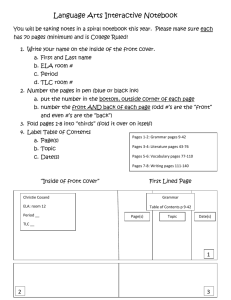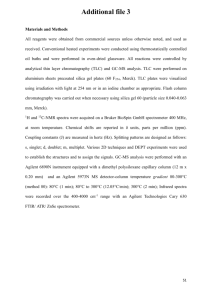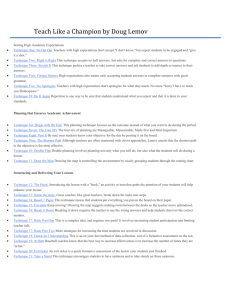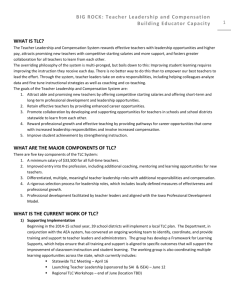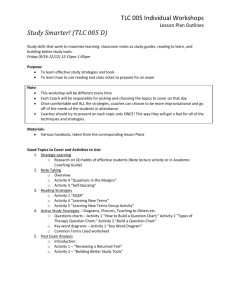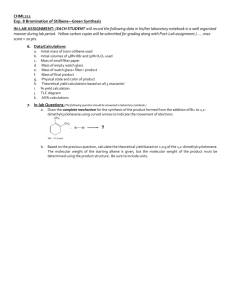ED 200 Foundations of Education and Language Arts Strategies
advertisement
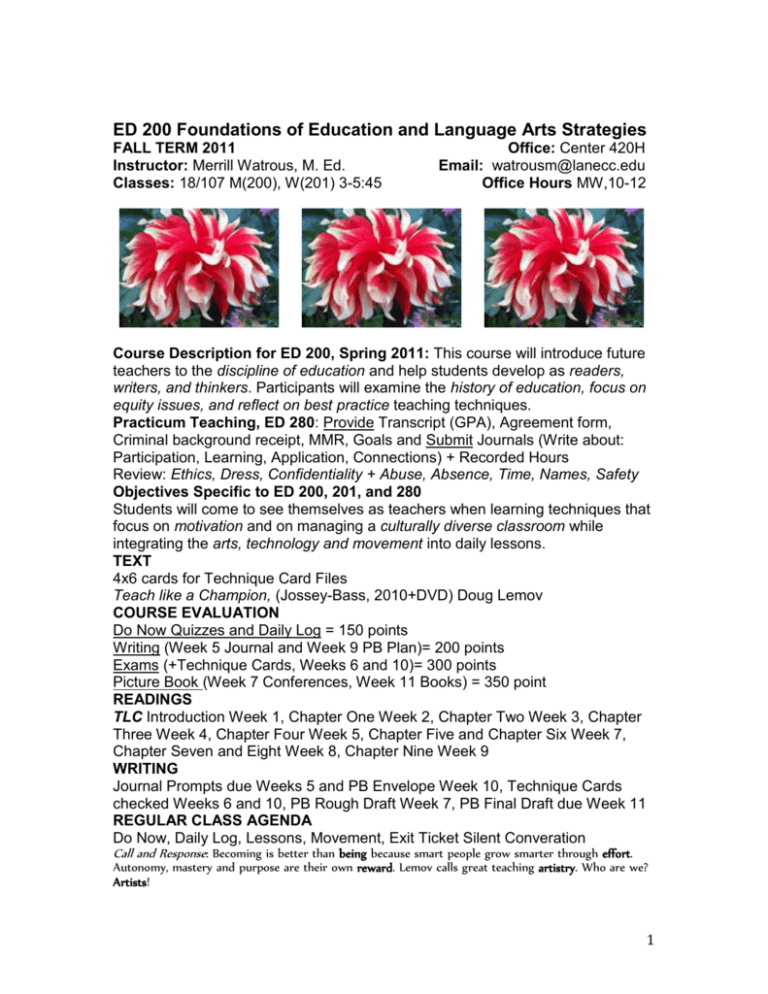
ED 200 Foundations of Education and Language Arts Strategies FALL TERM 2011 Instructor: Merrill Watrous, M. Ed. Classes: 18/107 M(200), W(201) 3-5:45 Office: Center 420H Email: watrousm@lanecc.edu Office Hours MW,10-12 Course Description for ED 200, Spring 2011: This course will introduce future teachers to the discipline of education and help students develop as readers, writers, and thinkers. Participants will examine the history of education, focus on equity issues, and reflect on best practice teaching techniques. Practicum Teaching, ED 280: Provide Transcript (GPA), Agreement form, Criminal background receipt, MMR, Goals and Submit Journals (Write about: Participation, Learning, Application, Connections) + Recorded Hours Review: Ethics, Dress, Confidentiality + Abuse, Absence, Time, Names, Safety Objectives Specific to ED 200, 201, and 280 Students will come to see themselves as teachers when learning techniques that focus on motivation and on managing a culturally diverse classroom while integrating the arts, technology and movement into daily lessons. TEXT 4x6 cards for Technique Card Files Teach like a Champion, (Jossey-Bass, 2010+DVD) Doug Lemov COURSE EVALUATION Do Now Quizzes and Daily Log = 150 points Writing (Week 5 Journal and Week 9 PB Plan)= 200 points Exams (+Technique Cards, Weeks 6 and 10)= 300 points Picture Book (Week 7 Conferences, Week 11 Books) = 350 point READINGS TLC Introduction Week 1, Chapter One Week 2, Chapter Two Week 3, Chapter Three Week 4, Chapter Four Week 5, Chapter Five and Chapter Six Week 7, Chapter Seven and Eight Week 8, Chapter Nine Week 9 WRITING Journal Prompts due Weeks 5 and PB Envelope Week 10, Technique Cards checked Weeks 6 and 10, PB Rough Draft Week 7, PB Final Draft due Week 11 REGULAR CLASS AGENDA Do Now, Daily Log, Lessons, Movement, Exit Ticket Silent Converation Call and Response: Becoming is better than being because smart people grow smarter through effort. Autonomy, mastery and purpose are their own reward. Lemov calls great teaching artistry. Who are we? Artists! 1 Week One, September 26th DO NOW 1. Photographs and Information Cards: Name, Address, Phone, Birthday, Email + Transfer plans. 2. Dear Merrill Letter (Attach at 5:30 to Exit Ticket) Why I want to be a teacher . . . Why I enrolled in the Lane Teaching Program . . . All About Me as a Learner (Challenges I face this term and Strengths I’ll build on) MAIN LESSON About the Teacher(s), About the Students Power of 3: About the Syllabus, Journals, Picture Books TLC: Technique 44 on Precise Praise ABOUT ME Fixed Mindset Thinkers . . . (I have to already be) I can learn new things, but I can’t change how smart I am. Smart people don’t have to work hard. I am sensitive about being wrong and about making mistakes since success is about proving I am smart. I want a partner who will put me on a pedestal. ABOUT ME Growth Mindset Thinkers . . . (Becoming is better than being) No matter how smart I am, I can always change it up substantially since working hard makes me smarter. I can confront obstacles by stretching myself, learning something new, and developing as a person. I want a partner who will help foster my development. DAILY LOG 1. Sign up for your day to teach (Daily Log): Weeks 2,3,4,5,6,7, 8 or 9. 2. Review, Extend and Teach concepts by incorporating technology, the arts, and the readings into one joint 15 minute presentation in order to fill in holes each week. 3. Conclude with a one-paragraph reflection about your lesson. What worked? What didn’t? Submit this to The Daily Log Forum on Moodle. SECONDARY LESSON Expectations:On time,Cell phones off, Hands free (No Food), Ready to Talk the Readings http://www.ted.com/talks/dan_pink_on_motivation.html SILENT CONVERSATION Exit Ticket Weeks 1-5 (Partner Name Added) -Pink talked for 18 minutes about motivation. Rewards and punishment don’t work as we thought they do? This surprised me, but then I don’t learn for grades either. -Autonomy, mastery, and purpose? These govern why I learn, so it makes sense to me that they are important to children as well. -If big time rewards do not lead to big time performances, how should I encourage kids? JOURNAL PROMPTS TO PREPARE FOR WEEK TWO 2 Purchase a manila folder for your journal. Create a selfportrait for the cover. Read online about drawing faces. Type up the following Table of Contents for your journal. The 14 titles should match the 14 prompts. Journal Table of Contents Print up of First Picture Book Email (Merrill’s Response) and Web Drawing Lesson on Portraits Three Champion Teachers and Why They Shine Mindset and Praise The Downside of Rewards as a Motivators Setting High Expectations Legacy Book Picture Book Review A My Ideal Classroom Map Legacy Book Picture Book Review B I am from . . . A Poem Two Stairways Dear Teacher (To a Mentor) Ratio At Bats and Learning Legacy Book Picture Book Review C 1. Email Merrill your first picture book ideas. Print up her response. 2. Lemov introduces you to seven champion teachers. Choose three and describe how you hope to become like them when you begin your career. 3. Reread p. 2 “About Me” statements from Dweck’s Mindset. View YouTube video(s) by Carol Dweck about Mindset and by Dr. C. Carter and Author K. Corrigan about How to Praise Students. Summarize and reflect. Week Two, October 3rd DO NOW – Closed Books but Open Notes MAIN LESSON TLC Chapter One No Opt Out: Writing Lesson on Verb Choice (4 formats, pp. 32-34 – James and Teacher role played by students) Right is Right: Review Verb Choice Lesson and 4 category responses (pp. 37-39) Stretch It: MW models with questions based on Ch 1 Format Matters: the Journals and Technique Cards Without Apology: Teaching Stories from the Class SECONDARY LESSON Introduction to Legacy Picture Books with TED talk by Sir Ken Robinson http://www.ted.com/talks/ken_robinson_says_schools_kill_creativity.html SILENT CONVERSATION -Right is Right is about setting high expectations. I want to set such expectations for myself and for my students; Ken Robinson inspires me to integrate the arts. -Without Apology is an important technique to master. Too many of my teachers have apologized for the content of their classes; this has never helped me to learn. 3 JOURNAL PROMPTS TO PREPARE FOR WEEK THREE 4. Re-view Pink’s TED. What did you learn about autonomy, mastery and purpose and how rewards and punishments hinder creativity? Dweck tells us to praise only effort, not smarts. Why? 5. Describe three techniques introduced in Chapter One in detail; make connections between what Lemov teaches and your own experiences as a student. Then summarize what Lemov writes about good I, You, and We. 6. Read and review one picture book this week. Summarize the story, comment on the artwork, and describe one aspect of the book that you think you might use for your own book. Week Three, October 10th MAIN LESSON TLC Chapter Two Begin with the End: Reading Aloud from p. 58 Mockingbird lesson; Planning Daily Log with Week Four Group – What do they want us to understand? 4MS/Post It: Daily (Weekly 200) Posted Objectives / INTASC Standards Shortest Path: How ED 200 Changes Term by Term Draw the Map: Teaching Philosophy and Use of Space (“Everything teaches”) SECONDARY LESSON Introduction to I AM FROM poem with Theresa Haley’s Poem on Teacher Tube http://teachertube.com/viewVideo.php?video_id=191803&title=I_am_from&ref=Thaley123"> Brainstorm WE ARE FROM classroom ED 200 poem SILENT CONVERSATION EXIT TICKET -I Begin with the End as a student as I plan for the next three months. -Theresa’s poem invites me to think about how teaching begins with relationships. JOURNAL PROMPTS TO PREPARE FOR WEEK FOUR 7. Draw the Map for your own future classroom. Create aisles and alleys but follow Lemov’s default map only if you choose to. Plan for 30. Pay attention to what you are going to put on the walls and how you will incorporate art and nature into your space. 8. Read and review one picture book this week. Summarize the story, comment on the artwork, and describe one aspect of the book that you think you might use for your own book. 9. Write am I AM FROM to share in class Week 4. See models at: http://www.studyguide.org/where_I%27m_from_poem.htm Call and Response: Becoming is better than being because smart people grow smarter through effort. Autonomy, mastery and purpose are their own reward. Lemov calls great teaching artistry. Who are we becoming? Artists! Week Four, October 17th MAIN LESSON 4 TLC Chapter Three Hook: Examples p. 76; Meet in Groups to create hooks (Short, Yielding, Energetic) to introduce a lesson for the Picture Book on Setting, Plot, or Characterization Name the Steps: Mnemonics you know and love (I before e . . . 30 days hath September . . . In 19 hundred and 42 . . .) and Creating Technique Mnemonics Circulate: Proximity counts, Teachers must own the whole room, Power behind Ratio and Batch Processing: Why the volleyball and not the soccer analogy? At Bats: Review of Math Courses at HS and LCC and Amount of Practice SECONDARY LESSON: Emulative Writing: “I Am From” Poetry Shared with Small Groups for Response SILENT CONVERSATION -There is so much to learn in TLC and it’s not easy to remember it all, but I can’t wait to apply what I am learning in a practicum classroom. -I enjoyed sharing my “I am from” poem but I was a bit intimidated about sharing it at first. I surprised myself by going deeper than I’d thought I would. JOURNAL PROMPTS TO PREPARE FOR WEEK FIVE 10. Why is ‘Using Two Stairways’ an important component of Name the Steps? 11. Write a thank you letter to a beloved “Lemov-esque” teacher who inspired you by setting high expectations for you, planning to ensure real achievement, and structuring and delivering lessons that worked. 12. Describe experiences you’ve had with Ratio that worked (small group work of limited duration where the teacher supported students) and didn’t (small group work that failed or fell apart). 13. How important are At Bats in learning a foreign language and why? 14. Read and review one picture book this week. Summarize the story, comment on the art, and describe an aspect of the book you might use. Week Five, October 24th MAIN LESSON Journals: Respond to 2 Peers’ Portraits and Starred Entries with Precise Praise TLC Chapter 4 Cold Call: How, when, and what does it feel like? Wait Time: How important is the use of evidence in class discussion? Everybody Writes: Rank order the 6 benefits and explain why Vegas: Look at Weeks 2-5 Daily Logs and how Vegas reinforced objectives Michael Geisen, Oregon + National Teacher of Year, Engages his Scientists with Art! http://www.opb.org/teachingcreativity/ SECONDARY LESSON Midterm Review: TLC through Chapter Four Short Answer, Word Bank, and Essay Questions along with Technique Card Check and Mystery Names SILENT CONVERSATION 5 I am (not) worried about the midterm because . . . Week Six, October 31st MAIN LESSON: Midterm - Open Technique Cards (Except while checked) SECONDARY LESSON http://www.readingrockets.org/books/interviews/polacco Group Journal Response (Weeks 6-10=PB Planning Envelope for Journal) Picture Book SSR and Thank you, Mr. Falker by Patricia Polacco Week Seven, Nov. 7th (Writing Conferences M and W with Merrill) MAIN LESSON TLC Chapters Five and Six (Bring Technique Cards to Class Weekly Now) Five Principles of Classroom Culture (pp. 146-150) Tight Transitions and Singing in K and Military Binder Control and Explicitly Teaching Organizational Skills 100% and Sustainable Compliance (Least Invasive Intervention pp. 172-173) What to Do and Directions (P. 179) Principles of Strong Voice (p. 183) No Warnings (Act early, reliably, proportionately) SECONDARY LESSON Picture Book Planning Envelope, Due Week 9 1. Storyboard (quick sketches and story outline) 2. Meeting with MW – Summary of Results (What did you learn?) 3. Meeting with Writing Tutor – Summary of Results (What did you learn?) 4. Meeting with Peer – Summary of Results (What did you learn?) 5. Review of 3 Legacy Picture Books 6. Self Assessment What are you proudest of accomplishing in your book? What might you do differently if you were to write a sequel? What did you learn about: Design (Cover, Title Page, About the Author, Dedication, Bibliography, Pagination, Binding, Border art) and Writing (Revision with Focus on Verb, Tenses, Research into setting and character, Working with Partners, Conferencing, Polishing and Editing) How might you teach with this book someday? PEER RESPONSE a. Read the whole story. Underline wording that speaks to you. Write at the top of the first page a sincere and specific compliment (3-4 sentences). b. Think about questions or suggestions that you can phrase as questions. Number the lines and attach a response page with these questions. Example: The “cat” sentence confused me. Could you simplify it with another verb? Week Eight, November 14th MAIN LESSON 6 TLC Chapter Seven Positive Framing: Six Rules to Consider and Power of Narrating the + Precise Praise: Genuine, Specific, About Effort and the Exceptional The Warm/Strict Paradox: Warm support while explaining temporary consequences J Factor: For the hardest work we do, PBL and the PB Emotional Constancy: It’s about them, not about us Explain Everything: Pro- and not re- active TLC Chapter Eight Pacing as the Illusion of Speed Change the Pace, not the Topic Brighten Lines at the Beginning and the End Every Minute Matters Look Forward with an agenda and Work the Clock Normalize Error: and Diana Laufenberg (TED) on How to Learn from Mistakes SECONDARY LESSON Final Exam Review Picture Book Final Notes on Picture Book Planning Envelope Week Nine, November 21st MAIN LESSON Power Point History of American Education (ED 201 Preview) TLC Chapter Nine: Simple to Complex, Hit Rate and *? Review SECONDARY LESSON Review for Final Exam *Make up reading summaries (Do Now) must be emailed by Monday for Credit Week Ten, November 28th Hand in Picture Book Planning Envelopes 1. Storyboard (quick sketches and story outline) 2. Meeting with MW – Summary of Results (What did you learn?) 3. Meeting with Writing Tutor – Summary of Results (What did you learn?) 4. Meeting with Peer – Summary of Results (What did you learn?) 5. Review of 3 Legacy Picture Books 6. Self Assessment Final Q and A on PB (Published Next Week, Copies or CDs gratefully accepted) FINAL EXAM (Short Answer Questions, Open File Technique Cards) Week Eleven, December 5th 2:00 Exam Schedule Picture Book Celebration REVISED 1000 POINT TRACKER DO NOW AVERAGE PERCENT _______ (100 points) Absent? You can recoup some points with timely emailed summaries. DAILY LOG Presentation and Moodle Reflection ____________ (50 points) 7 Response Journal 150 points Journal # 1 _______ 50 points Picture Book Planning Envelope _______ Exams I look for clear and organized writing on the essays and accuracy on the short answer questions. Careful reading and time invested in study is important for success with exams. 150 points Midterm _________ 150 points Final _________ Picture Book I look for evidence of persistent work throughout the term, thoughtful reviews of legacy work, and attention to both illustrations and design as well as careful revision of the text of the story. Cite all research. Practice presenting the book. 350 points _________________ 8


